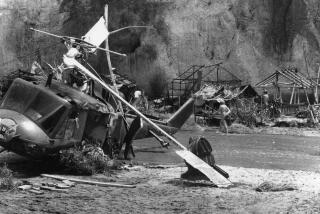King of Crooked Car Crashes Slams Into the Law
- Share via
NEW YORK — On the night of July 16, 2000, police arrived at the scene of one of Quentin Hawkins’ “movies.”
Two banged-up cars sat on a Brooklyn street where an open fire hydrant spit out water. Drivers and passengers reported that one car went out of control on the slick pavement and sideswiped the other.
But that hadn’t happened. The wreck wasn’t real: All of the “victims,” including an off-duty cop, were used by Hawkins in the biggest staged-accident scheme in state history.
Hawkins, 53, of Brooklyn, produced and directed perhaps hundreds of car accidents over two decades before federal agents broke up his ring and began bringing its members to court this year. His demolition derby, authorities say, was a major part of a costly epidemic in auto insurance fraud and set a new standard for the hustlers known as “runners.”
“He was, in a real sense, the king of the runners,” Assistant U.S. Atty. Daniel R. Alonso said when Hawkins, nicknamed “Flint,” was sentenced in September to five years and four months in prison.
Hawkins’ cast of con men featured his two adult children, a girlfriend half his age, crooked cops, a failed professional wrestler and regulars at a Brooklyn bowling alley called Melody Lanes.
One of the police officers, Edwin DeLoatch, was convicted last month of helping Hawkins orchestrate the two-car accident in Brooklyn in exchange for an envelope stuffed with an undisclosed amount of cash, slipped to him at Melody Lanes. He faces a sentence of three years and seven months.
Also among the 67 defendants named in the federal complaint was the manager of a medical clinic, Garri Zhigun. He awaits trial in December for allegedly billing insurance companies for unnecessary physical and psychiatric therapy.
Other medical clinics and law practices remain under investigation.
“Cases of this kind prove that greed knows no bounds,” Gregory Serio, superintendent of the New York Insurance Department, said after Hawkins’ arrest.
Hawkins thrived in an underworld populated by shady personal-injury lawyers and medical clinic operators who rely on runners to profit from false negligence and no-fault claims.
The corrupt clinics exploit New York’s no-fault law, which requires insurance companies to pay up to $50,000 per person for medical costs, lost wages and other expenses.
Fake victims, after refusing treatment at the scene, receive kickbacks from the clinics for seeking treatment for head, back and neck pain, or other “soft-tissue injuries” that are difficult to prove.
After receiving unnecessary treatment, some phony victims file lawsuits demanding damages for pain and suffering. The suits can reap five-figure settlements.
New York insurance officials estimate that no-fault claims from staged accidents amount to tens of millions of dollars each year in the state, and hundreds of millions nationwide. As a result, they say, the state has some of the highest auto insurance rates in the nation.
Fraud cases abound:
* In July in Newark, N.J., 28 people were charged with staging fake accidents. The owner of several chiropractic clinics, identified as the ringleader, was charged with submitting more than $300,000 in phony medical claims.
* Earlier this year, California officials announced that a statewide crackdown had resulted in convictions of 51 people in San Diego, Los Angeles and San Francisco. The defendants included five chiropractors and seven lawyers.
* In April, a law office manager for firms in Houston and Dallas was ordered to pay $8.7 million in restitution for his role in a fraudulent accident ring. Authorities alleged that the ring was run by Russian organized crime groups.
How Hawkins ended up launching his lucrative career as a runner remains unclear. But his girlfriend testified that he boasted that he’d been at it for 21 years. At Melody Lanes, Hawkins stood out from the blue-collar crowd.
“Flint Hawkins is the kind of guy who drives a nice big car,” said Steven Brounstein, an attorney for DeLoatch. “He wears nice jewelry. He’s a big talker.”
When Hawkins talked to his fellow bowlers about an easy way to make quick cash, they listened.
The king of the runners collected up to $2,000 in kickbacks per car accident “victim” that he delivered to clinics. He used middlemen to help recruit and direct drivers and passengers to have deliberate, low-impact collisions; the fake victims received about $200 each and the chance to file lawsuits.
In some cases, Hawkins went a step further.
He bribed another police officer, Rodney Hawkins, no relation, to write fake reports, eliminating the need for the usual theatrics. The officer pleaded guilty to charges that he wrote at least seven bogus accident reports involving a total of 37 people claiming to have been injured by phantom hit-and-run drivers.
An FBI wiretap on Hawkins’ cell phone revealed that the ring relied on code: The scripted accidents were “movies,” cars were “cans,” and patients were “pineapples” who needed to go to “fruit stands” or medical clinics.
Hawkins was clear about who was boss.
“There is only one chief, and I’m the chief,” he said in a taped conversation with one of his minions. “And you do it my way.”
Hawkins got away with his staged-accident scheme until authorities received a tip about another of his scams.
Parents of children who were tested for lead poisoning reported that health care workers were harassing them by trying to steer them to certain medical clinics.
Using wiretaps, investigators uncovered Hawkins’ plot to pay more than $10,000 in bribes to hospital employees for the names of the children, as well as people injured in car accidents.
Authorities also heard something else: Hawkins congratulating DeLoatch for staging a car crash on a street with an open fire hydrant.
“I never would have thought of that,” Hawkins said. “That was very ingenious.”
More to Read
Sign up for Essential California
The most important California stories and recommendations in your inbox every morning.
You may occasionally receive promotional content from the Los Angeles Times.










